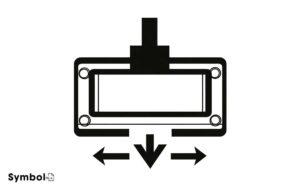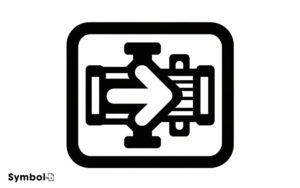Normally Closed Flow Switch Symbol: Explain!
A normally closed flow switch symbol represents a device in your control system that stays closed until activated by fluid movement. This default closed position guarantees safety and system control, essential in applications needing a fail-safe.
The symbol itself is key in engineering, offering a clear, unambiguous representation of the switch’s function and state. It shows the flow direction and operation mode without words, allowing quick interpretation.
Understanding this symbol is critical for designing and troubleshooting flow control systems. Grasping its meaning elevates your ability to manage and optimize system performance, teeing you up for advanced system insights.

Key Takeaways
Understanding Flow Switches
Flow switches, integral to monitoring and controlling the flow of liquids or gases in pipes, operate by sending a signal once the flow reaches a specified threshold.
As you explore further, you’ll appreciate how these devices are crucial in ensuring systems operate efficiently and safely.
Their functionality hinges on detecting flow rate changes, triggering a response to maintain or adjust the flow to desired levels.
This capability is essential in applications where precise flow control is critical, such as in chemical processing or HVAC systems.
Understanding the mechanics behind flow switches involves grasping how they sense flow movement and convert this detection into actionable output.
This foundational knowledge is essential for anyone looking to implement or troubleshoot flow control systems.
The Basics of Normally Closed
Building on your understanding of flow switches, it’s important to grasp what normally closed means in this situation, as it directly impacts how these devices function in controlling fluid dynamics.
A normally closed (NC) flow switch maintains a closed state, blocking flow, until activated by a specified fluid movement or level.
This default position guarantees safety and control, preventing the passage of fluid unless conditions meet predefined criteria.
The mechanism’s design allows it to respond to changes in flow or pressure, opening to permit fluid passage only when necessary.
This operational mode is vital for systems requiring a fail-safe position to avoid unintentional flow, ensuring that control is maintained until an intentional change in conditions prompts an adjustment.
Understanding this principle is foundational in leveraging flow switch capabilities efficiently.
Symbol Representation
You must grasp the fundamentals of symbol representation to accurately interpret and utilize normally closed flow switches.
This section dissects the design components, ensuring you understand their roles and implications.
Highlighting practical applications, it’ll clarify how these symbols are employed in real-world scenarios, enhancing your technical fluency.
Understanding Symbol Basics
To grasp the concept of a normally closed flow switch symbol, it’s important to first understand the basic symbols used in technical diagrams.
These symbols are the language of engineering and automation, allowing for clear communication across diverse technical fields.
A normally closed flow switch, for instance, is depicted with specific symbols that denote its function and state without ambiguity.
Understanding these symbols involves recognizing the graphical representations that indicate flow paths, states of operation (closed, open), and the switch’s interaction with the fluid it controls.
Mastery of these symbols is essential; they enable you to interpret and design complex control systems.
Each line, curve, and intersection has a precise meaning, ensuring that you can accurately convey and interpret the operational characteristics of the flow switch.
Design Components Explained
Having grasped the basics of symbols, let’s focus on the specific design components and their representation in a normally closed flow switch symbol.
| Component | Symbol Representation | Function |
|---|---|---|
| Actuator | Diagonal Arrow | Initiates switch action |
| Flow Path | Solid Line | Indicates direction of flow |
| Terminal Contacts | Crossed Lines | Show electrical connections |
| Normal Position | Horizontal Line | Represents switch’s default state |
| Operative Position | Angled Line | Depicts switch state when activated |
Each component plays a critical role in portraying the switch’s function and operational state. Understanding these symbols allows for accurate interpretation of schematic diagrams, ensuring precise and efficient communication among professionals.
Practical Applications Highlighted
Understanding the symbol representation of a normally closed flow switch reveals its practical applications in various industrial settings, enabling streamlined troubleshooting and system design.
By recognizing this symbol, you’re equipped to comprehend where and how these switches play a critical role in system operations.
- Cooling Systems Control: Guarantees that coolant flow is maintained, preventing overheating in machinery.
- Safety Interlocks: Acts as a failsafe in chemical processing, halting operations if fluid flow is interrupted.
- Water Treatment: Monitors and controls the flow of water in treatment facilities, safeguarding against system failures.
- HVAC Systems: Regulates airflow, contributing to efficient heating, ventilation, and air conditioning performance.
This technical insight empowers you to identify and apply these switches effectively, enhancing system reliability and safety.
Key Applications
You’ll find the normally closed flow switch symbol prominently in industrial process control and water management systems. Its role is critical for monitoring and controlling the flow of liquids, ensuring systems operate within safe and efficient parameters.
Understanding its applications, you can optimize system performance and prevent potential failures.
Industrial Process Control
In industrial process control, crucial closed flow switches play a pivotal role in monitoring and regulating fluid movement through pipelines to ensure operational safety and efficiency.
These switches are critical in various sectors, ensuring that processes run smoothly and safely by providing valuable data on flow rates and conditions.
To grasp their importance:
- Detecting Flow Interruptions: Instantly identifies any disruption in fluid flow, preventing potential damage to equipment.
- Automated Control: Facilitates automatic system adjustments based on real-time flow data.
- Safety Measures: Acts as a safeguard against flow-related anomalies that could lead to hazardous situations.
- Process Optimization: Enables fine-tuning of processes for maximum efficiency and output by ensuring ideal fluid flow.
Understanding these applications empowers you to appreciate the significance of normally closed flow switches in industrial process control.
Water Management Systems
Amid rapidly evolving water management systems, normally closed flow switches are essential for monitoring and controlling water flow, ensuring both efficiency and safety across various applications.
You’ll find these switches crucial in applications like irrigation, where precise water distribution is critical. They enable systems to maintain ideal water levels in tanks and reservoirs, automatically shutting off flow to prevent overflow or depletion.
In wastewater treatment, these switches help in regulating the flow of water through treatment stages, ensuring that each phase operates within its capacity and efficiently processes the water.
Their role in detecting flow interruptions can prevent pump damage and system failures, underscoring their importance in maintaining operational continuity and safeguarding water quality.
Operating Principles
How does a normally closed flow switch operate, and what principles underlie its functionality?
In essence, a normally closed flow switch maintains a circuit in a closed state, allowing current to flow until a specific fluid flow condition triggers it to open, interrupting the current.
The operation of such a device is grounded in several fundamental principles:
- Magnetic actuation: Utilizes magnetic fields to mechanically open or close the switch in response to flow changes.
- Pressure differential detection: Senses changes in pressure caused by fluid flow to operate the switch.
- Thermal dispersion: Measures the cooling effect of fluid flow on a heated element to determine flow presence.
- Paddle or vane actuation: Employs a physical paddle or vane moved by fluid flow to trigger the switch mechanism.
Understanding these principles facilitates a deeper grasp of how normally closed flow switches contribute to precise fluid control.
Installation Guidelines
To guarantee peak performance, you must attentively follow the manufacturer’s installation guidelines when setting up your normally closed flow switch.
Begin by ensuring the switch’s orientation aligns with the flow direction, as indicated by arrows on the device. This is critical for accurate operation.
Next, verify the compatibility of your piping material and the fluid type with the switch specifications to prevent corrosion or damage.
It’s also essential to install the switch in a section of the pipe where there’s a stable flow, avoiding areas near pumps or valves where turbulence might occur.
Secure the switch firmly to prevent any movement that could affect its accuracy. Finally, connect the electrical wiring according to the schematic provided, ensuring a tight and secure connection to avoid any signal interruption.
Troubleshooting Tips
After carefully following the installation guidelines for your typically closed flow switch, it’s important to know how to effectively troubleshoot potential issues that may arise during its operation.
- Check Electrical Connections: Ensure all wiring is secure and free from corrosion.
- Inspect the Flow Path: Verify there are no obstructions that could impede fluid flow.
- Evaluate the Switch Setting: Confirm the switch is set to the correct flow parameters for your system.
- Monitor for Leakage: Look for any signs of leakage around the switch body, which could indicate a seal failure.
Addressing these areas promptly can prevent operational disruptions, ensuring your system maintains peak performance.
Understanding these troubleshooting steps is essential for diagnosing and rectifying common problems encountered with typically closed flow switches.
Maintenance Practices
You must establish routine inspection schedules to guarantee the longevity and reliability of normally closed flow switches.
Identifying and troubleshooting common issues early can prevent system failures and maintain operational efficiency.
This proactive approach not only minimizes downtime but also optimizes performance and safety standards.
Routine Inspection Schedules
Establishing a routine inspection schedule is vital for guaranteeing the longevity and reliability of normally closed flow switches in industrial settings. You need to prioritize this to avoid unexpected downtimes and maintain operational efficiency.
Here are key components to focus on during these inspections:
- Visual Inspection: Check for any physical damages or signs of wear and tear.
- Functional Testing: Verify the switch activates and deactivates at the correct flow rates.
- Electrical Connections: Ensure all wiring is secure and free of corrosion.
- Calibration Check: Confirm the switch’s accuracy against known standards.
Adhering to these inspection points can greatly reduce the risk of malfunction, ensuring that your flow switches operate effectively and reliably. This proactive approach is pivotal in maintaining the integrity of your systems.
Troubleshooting Common Issues
Despite routine inspections, you may encounter issues with normally closed flow switches that require precise troubleshooting to maintain top performance.
If you’re facing erratic readings or total failure, start by verifying the power supply and electrical connections. These components are often critical behind malfunctioning switches.
Next, inspect the paddle or float for obstructions or damage. Debris can hinder movement, leading to inaccurate flow detection. It’s also essential to check for leaks or pressure changes in the system that could affect switch operation.
Analyze the calibration settings; incorrect parameters can cause the switch to act prematurely or not at all. Finally, consult the manufacturer’s documentation for specific troubleshooting steps related to your model.
Accurate diagnosis guarantees efficient repair, minimizing downtime and maintaining system integrity.
Common Challenges
Incorporating a normally closed flow switch into a hydraulic system often presents several challenges, particularly in calibration and maintenance.
You’re likely to encounter a range of technical hurdles that demand precise attention and understanding. These challenges not only affect the performance but also the reliability of the system.
To navigate through these complexities, it’s essential to grasp the specifics:
- Precise Calibration: Achieving accurate calibration settings to ensure peak performance.
- Regular Maintenance: Implementing a strict maintenance schedule to prevent failures.
- Compatibility Issues: Ensuring the switch is compatible with the fluid type and the system’s pressure requirements.
- Environmental Factors: Guarding against external conditions that could impact switch functionality, such as temperature fluctuations and contamination.
Addressing these challenges requires a meticulous approach, focusing on technical details and system specifications.
Safety Considerations
Understanding the common challenges of integrating a normally closed flow switch, it’s essential to also consider the safety aspects of its operation within hydraulic systems.
| Safety Feature | Description |
|---|---|
| Overpressure Protection | Prevents system damage or failure by relieving excessive pressure. |
| Leak Detection | Identifies system integrity issues, minimizing fluid loss and environmental hazards. |
| Electrical Safety | Guarantees the switch operates within safe electrical parameters to prevent shorts or fires. |
| Material Compatibility | Ensures the switch materials are resistant to the fluids in the system, avoiding corrosion. |
These considerations are vital for maintaining a secure operational environment. By focusing on these areas, you’ll mitigate risks associated with the mechanical and electrical components of the flow switch, ensuring a safer system overall.
Future Trends
As technology evolves, so too will the design and implementation of normally closed flow switches in hydraulic systems.
You’ll witness significant advancements that aim to enhance efficiency, reliability, and adaptability across various applications.
To capture the essence of these future trends, consider these key points:
- Integration of IoT capabilities for real-time monitoring and control
- Advancements in material science leading to more durable and sensitive switches
- Miniaturization of components to fit increasingly compact systems
- Increased focus on sustainability, with designs minimizing environmental impact
These developments won’t only redefine the operational standards but also improve the diagnostic capabilities of flow switches, ensuring systems are safer, more responsive, and energy-efficient.
You’re looking at a future where precision and sustainability converge in the domain of hydraulic systems.
Conclusion
To wrap up, you’ve navigated the technical domain of normally closed flow switches, understanding their symbol, applications, and operation.
Consider a pharmaceutical plant where precision in liquid handling is crucial. Here, a normally closed flow switch guarantees that essential ingredients are added at the correct time, safeguarding product consistency.
Regular maintenance and acknowledging safety considerations will mitigate challenges, keeping abreast of future trends. This insight not only enhances your technical acumen but also equips you to leverage these switches for efficiency and safety in critical applications.






